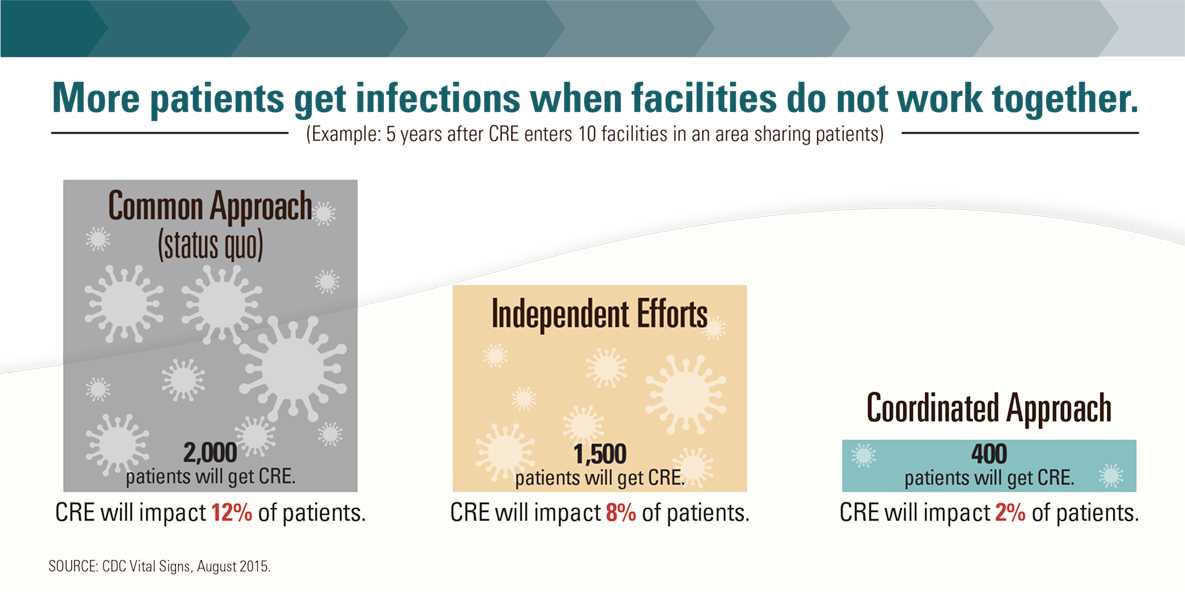CDC Supported Projects
Regional Approaches to Combating the Spread of Multi-drug Resistant Organisms
Multi-drug resistant organisms (MDROs) cause infections that can’t be treated by most known antibiotics. MDROs can spread from patient to patient, from patient to health care worker and from medical facility to medical facility.
Stopping the spread of MDROs saves lives
Ten to fifteen percent of all hospital patients and 65 percent of all nursing home residents are colonized with one or more MDRO, which means the MDRO is in, or on, their body but does not make them sick. While they may not get sick right away, being colonized puts the patient and others around them at a much higher risk for becoming infected later.
Complicating the matter is the common movement of patients between hospitals, nursing homes, other health care facilities and home. This movement provides more opportunity for MDROs to spread to others.
What can be done to stop the spread?
In order to stop the spread of MDROs, we must first prevent the spread of MDROs inside health care facilities, including nursing homes. Health departments should use information on how patients move between facilities in order to coordinate and focus interventions where they will have the most impact.
In the 2015 Vital Signs report, CDC outlined how public health and health care facilities can work together to focus activities, share experiences and connect patient safety efforts happening in their region to prevent the spread of MDROs between facilities. Now, CDC is supporting quality assurance and performance improvement projects targeting highly interconnected health facilities and the use of recommended disinfection interventions. (chlorhexidine bathing and nasal disinfection [PDF – 281 KB])

Current CDC Supported Projects
SHIELD Orange County
Shared Healthcare Intervention to Eliminate Life-threatening Dissemination of MDROs
 Local hospitals, long-term acute care hospitals and nursing homes in Orange County, California, are focusing on regional intervention using antiseptic soaps for bathing and cleansing the nose. This project involves 40 health care facilities that have patient transfer patterns that make MDRO spread more likely to occur between them. This intervention includes:
Local hospitals, long-term acute care hospitals and nursing homes in Orange County, California, are focusing on regional intervention using antiseptic soaps for bathing and cleansing the nose. This project involves 40 health care facilities that have patient transfer patterns that make MDRO spread more likely to occur between them. This intervention includes:
- Chlorhexidine antiseptic soap for routine bathing.
- Iodophor for nasal cleaning.
Part of this project involves studying patient movement patterns to see where patients go when they leave a health care facility. Did they go home? Did they go directly to another medical facility? Did they go to another health care facility after a stay at home? Understanding the pattern of movement helps us understand how MDROs are spreading between patients and facilities, and helps predict which facilities are most likely to see patients who have had an MDRO previously. This project will last four years and will demonstrate the effectiveness of the coordinated approach on reducing MDROs in health care settings across the entire community.
Chicago PROTECT (Providing Regional Organizations with TEchniques to ConTrol MDROs)
 The Chicago PROTECT project is a four-year program based out of Chicago, Illinois. It also uses information on how patients move between health care facilities to provide a blueprint for infection control strategy. This program focuses on reducing the spread of the highly-resistant bug carbapenem-resistant Enterobacteriaceae (CRE), and makes use of an established extensively drug resistant organism (XDRO) patient registry to target use of a bundle of interventions in selected facilities.
The Chicago PROTECT project is a four-year program based out of Chicago, Illinois. It also uses information on how patients move between health care facilities to provide a blueprint for infection control strategy. This program focuses on reducing the spread of the highly-resistant bug carbapenem-resistant Enterobacteriaceae (CRE), and makes use of an established extensively drug resistant organism (XDRO) patient registry to target use of a bundle of interventions in selected facilities.
The program will:
- Predict which facilities are likely to get high risk patients using patient transfer data.
- Have a multi-facility CRE patient alert system.
- Target interventions in facilities predicted to be higher risk, including patient screening for CRE, contact precautions and cohorting, chlorhexidine soap for bathing [PDF – 286 KB], and health care worker education / hand hygiene.
- Measure the impact of the program on regional spread of CRE.
- Include a cost-benefit analysis of CRE interventions.
Related Links
- Page last reviewed: February 28, 2017
- Page last updated: February 28, 2017
- Content source:


 ShareCompartir
ShareCompartir